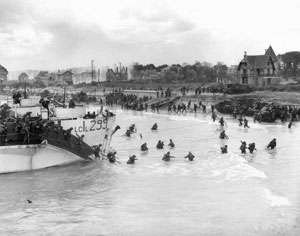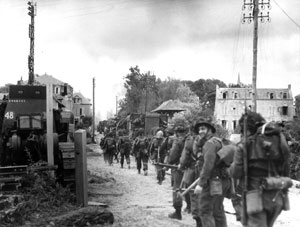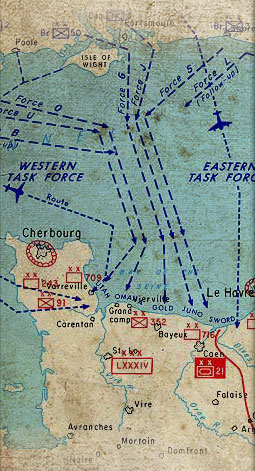
 The Canadian forces that landed on Juno Beach faced 2 heavy batteries of 155 mm guns and 9 medium batteries of 75 mm guns, as well as machine-gun nests, pillboxes, other concrete fortifications, and a seawall twice the height of the one at Omaha Beach. The first wave suffered 50% casualties, the second highest of the five D-Day beachheads. The use of armour was successful at Juno, in some instances actually landing ahead of the infantry as intended and helping clear a path inland.
The Canadian forces that landed on Juno Beach faced 2 heavy batteries of 155 mm guns and 9 medium batteries of 75 mm guns, as well as machine-gun nests, pillboxes, other concrete fortifications, and a seawall twice the height of the one at Omaha Beach. The first wave suffered 50% casualties, the second highest of the five D-Day beachheads. The use of armour was successful at Juno, in some instances actually landing ahead of the infantry as intended and helping clear a path inland.
Despite the obstacles, the Canadians were off the beach within hours and beginning their advance inland. A single troop of four tanks managed to reach the final objective phase line, but hastily retreated, having outrun its infantry support. In particular, two fortified positions at the Douvres Radar Station remained in German hands (and would for several days until captured by British commandos), and no link had been established with Sword Beach.
 By the end of D-Day, 30,000 Canadians had been successfully landed, and the 3rd Canadian Infantry Division had penetrated further into France than any other Allied force, despite having faced strong resistance at the water's edge and later counterattacks on the beachhead by elements of the German 21st and 12th SS Hitlerjugend (Hitler Youth) Panzer divisions on 7 June and 8 June.
By the end of D-Day, 30,000 Canadians had been successfully landed, and the 3rd Canadian Infantry Division had penetrated further into France than any other Allied force, despite having faced strong resistance at the water's edge and later counterattacks on the beachhead by elements of the German 21st and 12th SS Hitlerjugend (Hitler Youth) Panzer divisions on 7 June and 8 June.






